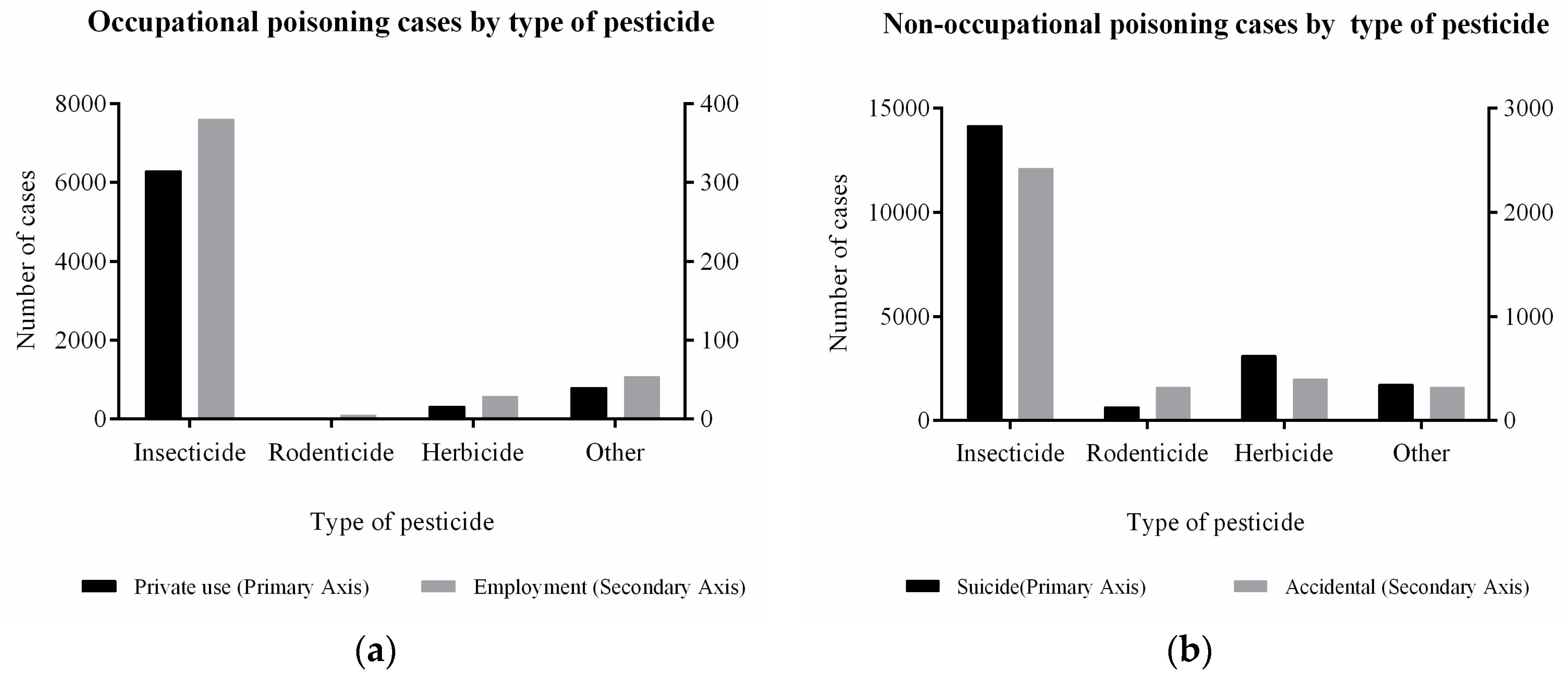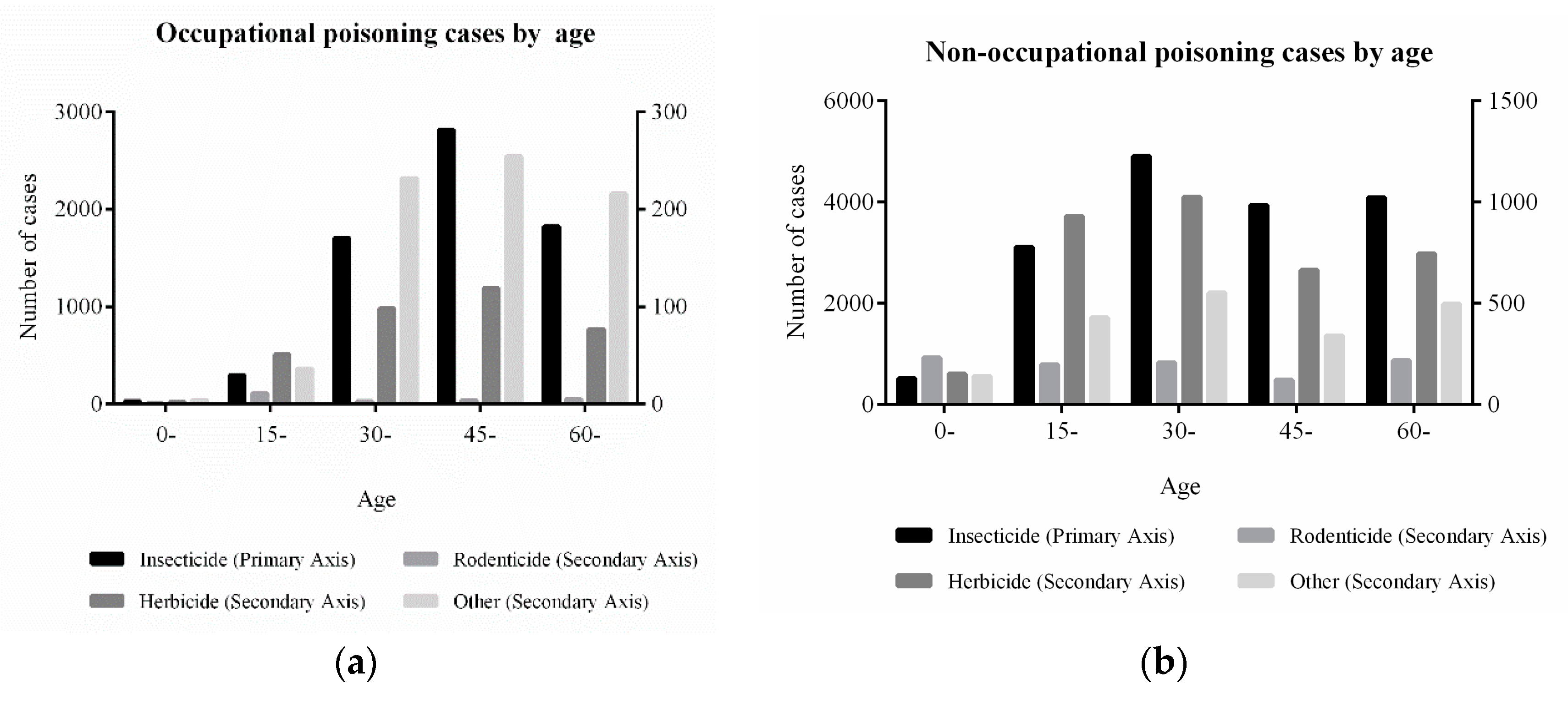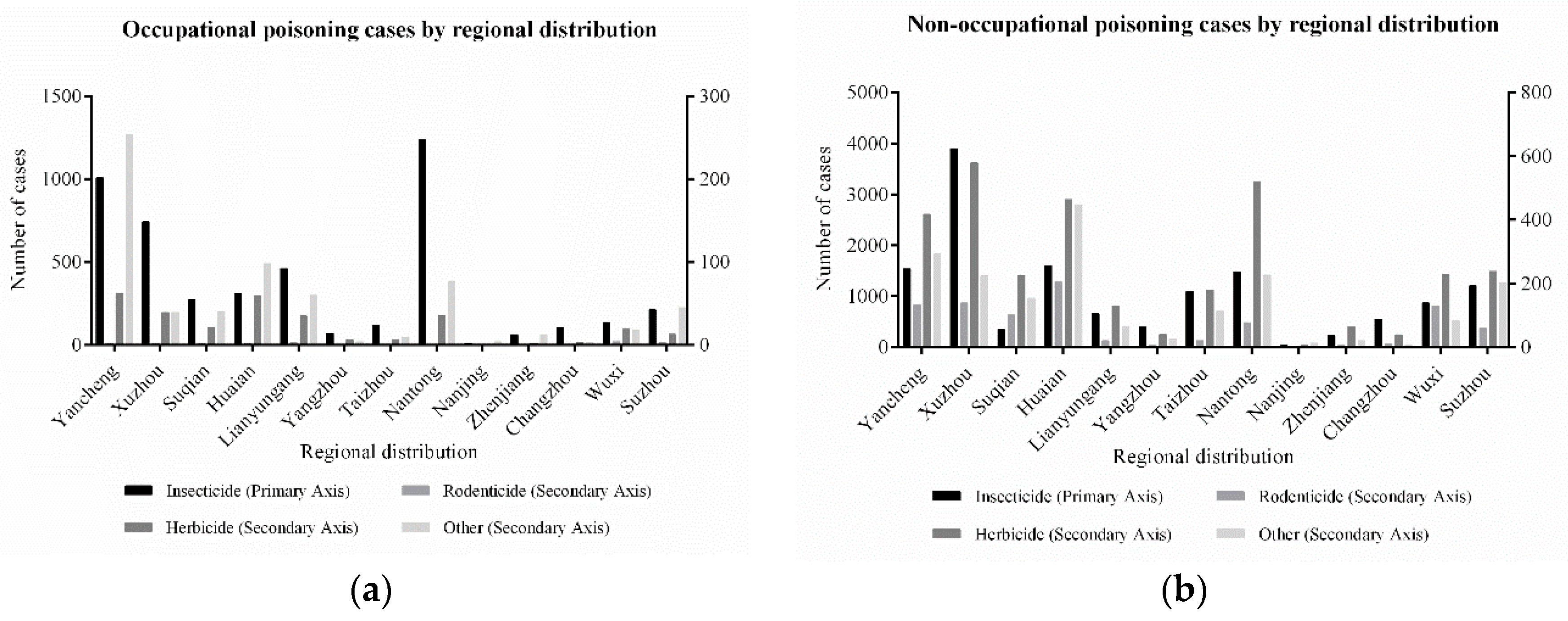Types of Exposure Pesticide Poisoning in Jiangsu Province, China; The Epidemiologic Trend between 2006 and 2018
Abstract
1. Introduction
2. Methods and Materials
2.1. Data Source
2.2. Case Definition
2.3. Data Analysis
2.4. Ethics
3. Results
3.1. Distribution of Pesticides Related to Pesticide Poisoning
3.2. Age Groups with Pesticide Poisoning Cases
3.3. Trend with Pesticide Poisoning
3.4. Season-Related Pesticide Poisoning
3.5. Prevalent Cases of Poisoning in Northern Jiangsu
4. Discussion
5. Conclusions
Author Contributions
Funding
Acknowledgments
Conflicts of Interest
References
- Huang, J.; Rozelle, S.; Pray, C.; Wang, Q. Plant biotechnology in China. Science 2002, 295, 674–676. [Google Scholar] [CrossRef] [PubMed]
- Cantrell, C.L.; Dayan, F.E.; Duke, S.O. Natural products as sources for new pesticides. J. Nat. Prod. 2012, 75, 1231–1242. [Google Scholar] [CrossRef] [PubMed]
- Ye, M.; Beach, J.; Martin, J.W.; Senthilselvan, A. Occupational pesticide exposures and respiratory health. Int. J. Environ. Res. Public Health 2013, 10, 6442–6471. [Google Scholar] [CrossRef] [PubMed]
- Subritzky, T.; Pettigrew, S.; Lenton, S. Into the void: Regulating pesticide use in Colorado’s commercial cannabis markets. Int. J. Drug Policy 2017, 42, 86–96. [Google Scholar] [CrossRef] [PubMed]
- Zhang, C.; Hu, R.; Huang, J.; Huang, X.; Shi, G.; Li, Y.; Yin, Y.; Chen, Z. Health effect of agricultural pesticide use in China: Implications for the development of GM crops. Sci. Rep. 2016, 6, 34918. [Google Scholar] [CrossRef] [PubMed]
- Mew, E.J.; Padmanathan, P.; Konradsen, F.; Eddleston, M.; Chang, S.S.; Phillips, M.R.; Gunnell, D. The global burden of fatal self-poisoning with pesticides 2006-15: Systematic review. J. Affect. Disord. 2017, 219, 93–104. [Google Scholar] [CrossRef] [PubMed]
- Zhang, C.; Hu, R.; Shi, G.; Jin, Y.; Robson, M.G.; Huang, X. Overuse or underuse? An observation of pesticide use in China. Sci. Total Environ. 2015, 538, 1–6. [Google Scholar] [CrossRef]
- Jin, J.; Wang, W.; He, R.; Gong, H. Pesticide Use and Risk Perceptions among Small-Scale Farmers in Anqiu County, China. Int. J. Environ. Res. Public Health 2016, 14, 29. [Google Scholar] [CrossRef]
- Damalas, C.A.; Eleftherohorinos, I.G. Pesticide exposure, safety issues, and risk assessment indicators. Int. J. Environ. Res. Public Health 2011, 8, 1402–1419. [Google Scholar] [CrossRef]
- Montgomery, M.P.; Kamel, F.; Hoppin, J.A.; Beane Freeman, L.E.; Alavanja, M.C.; Sandler, D.P. Effects of self-reported health conditions and pesticide exposures on probability of follow-up in a prospective cohort study. Am. J. Ind. Med. 2010, 53, 486–496. [Google Scholar] [CrossRef]
- Hu, R.; Huang, X.; Huang, J.; Li, Y.; Zhang, C.; Yin, Y.; Chen, Z.; Jin, Y.; Cai, J.; Cui, F. Long- and short-term health effects of pesticide exposure: A cohort study from China. PLoS ONE 2015, 10, e0128766. [Google Scholar] [CrossRef]
- Li, Y.; Zhang, C.; Yin, Y.; Cui, F.; Cai, J.; Chen, Z.; Jin, Y.; Robson, M.G.; Li, M.; Ren, Y.; et al. Neurological effects of pesticide use among farmers in China. Int. J. Environ. Res. Public Health 2014, 11, 3995–4006. [Google Scholar] [CrossRef]
- Wang, B.S.; Chen, L.; Li, X.T.; Xu, M.; Zhu, B.L.; Zhang, J. Acute Pesticide Poisoning in Jiangsu Province, China, from 2006 to 2015. Biomed. Environ. Sci. BES 2017, 30, 695–700. [Google Scholar] [CrossRef]
- Zhang, M.; Fang, X.; Zhou, L.; Su, L.; Zheng, J.; Jin, M.; Zou, H.; Chen, G. Pesticide poisoning in Zhejiang, China: A retrospective analysis of adult cases registration by occupational disease surveillance and reporting systems from 2006 to 2010. BMJ Open 2013, 3, e003510. [Google Scholar] [CrossRef]
- Konradsen, F. Acute pesticide poisoning—A global public health problem. Dan. Med Bull. 2007, 54, 58–59. [Google Scholar]
- Sapbamrer, R. Pesticide Use, Poisoning, and Knowledge and Unsafe Occupational Practices in Thailand. New Solut. A J. Environ. Occup. Health Policy 2018, 28, 283–302. [Google Scholar] [CrossRef]
- Wee, S.Y.; Aris, A.Z. Ecological risk estimation of organophosphorus pesticides in riverine ecosystems. Chemosphere 2017, 188, 575–581. [Google Scholar] [CrossRef]
- Rai, M.; Kon, K.; Ingle, A.; Duran, N.; Galdiero, S.; Galdiero, M. Broad-spectrum bioactivities of silver nanoparticles: The emerging trends and future prospects. Appl. Microbiol. Biotechnol. 2014, 98, 1951–1961. [Google Scholar] [CrossRef]
- Ibrahim, M.A.; Griko, N.; Junker, M.; Bulla, L.A. Bacillus thuringiensis: A genomics and proteomics perspective. Bioeng. Bugs 2010, 1, 31–50. [Google Scholar] [CrossRef]
- Grung, M.; Lin, Y.; Zhang, H.; Steen, A.O.; Huang, J.; Zhang, G.; Larssen, T. Pesticide levels and environmental risk in aquatic environments in China—A review. Environ. Int. 2015, 81, 87–97. [Google Scholar] [CrossRef]
- Lee, W.J.; Ko, Y.; Cha, E.S. Acute pesticide poisoning among children in South Korea: Findings from National Health Insurance claims data, 2006–2009. J. Trop. Pediatrics 2014, 60, 4–9. [Google Scholar] [CrossRef][Green Version]
- Ding, G.; Bao, Y. Revisiting pesticide exposure and children’s health: Focus on China. Sci. Total Environ. 2014, 472, 289–295. [Google Scholar] [CrossRef]
- Kim, Y.R.; Choi, K.H.; Oh, Y.; Lee, H.K.; Kweon, Y.S.; Lee, C.T.; Lee, K.U. Elderly suicide attempters by self-poisoning in Korea. Int. Psychogeriatr. 2011, 23, 979–985. [Google Scholar] [CrossRef]
- Knipe, D.W.; Metcalfe, C.; Fernando, R.; Pearson, M.; Konradsen, F.; Eddleston, M.; Gunnell, D. Suicide in Sri Lanka 1975–2012: Age, period and cohort analysis of police and hospital data. BMC Public Health 2014, 14, 839. [Google Scholar] [CrossRef]
- Rajapakse, T.; Christensen, H.; Cotton, S.; Griffiths, K.M. Non-fatal self-poisoning across age groups, in Sri Lanka. Asian J. Psychiatry 2016, 19, 79–84. [Google Scholar] [CrossRef]
- Li, X.H.; Leng, P.B.; Mao, G.C.; Wang, A.H. Analysis of acute pesticide poisoning in Ningbo city from 2011 to 2016. Zhonghua lao dong wei sheng zhi ye bing za zhi = Zhonghua laodong weisheng zhiyebing zazhi = Chin. J. Ind. Hyg. Occup. Dis. 2018, 36, 26–29. [Google Scholar] [CrossRef]





© 2019 by the authors. Licensee MDPI, Basel, Switzerland. This article is an open access article distributed under the terms and conditions of the Creative Commons Attribution (CC BY) license (http://creativecommons.org/licenses/by/4.0/).
Share and Cite
Wang, N.; Wang, B.; Wen, J.; Li, X.; Pan, L.; Zhang, J.; Zhu, B. Types of Exposure Pesticide Poisoning in Jiangsu Province, China; The Epidemiologic Trend between 2006 and 2018. Int. J. Environ. Res. Public Health 2019, 16, 2586. https://doi.org/10.3390/ijerph16142586
Wang N, Wang B, Wen J, Li X, Pan L, Zhang J, Zhu B. Types of Exposure Pesticide Poisoning in Jiangsu Province, China; The Epidemiologic Trend between 2006 and 2018. International Journal of Environmental Research and Public Health. 2019; 16(14):2586. https://doi.org/10.3390/ijerph16142586
Chicago/Turabian StyleWang, Ning, Boshen Wang, Jinbo Wen, Xiuting Li, Liping Pan, Juan Zhang, and Baoli Zhu. 2019. "Types of Exposure Pesticide Poisoning in Jiangsu Province, China; The Epidemiologic Trend between 2006 and 2018" International Journal of Environmental Research and Public Health 16, no. 14: 2586. https://doi.org/10.3390/ijerph16142586
APA StyleWang, N., Wang, B., Wen, J., Li, X., Pan, L., Zhang, J., & Zhu, B. (2019). Types of Exposure Pesticide Poisoning in Jiangsu Province, China; The Epidemiologic Trend between 2006 and 2018. International Journal of Environmental Research and Public Health, 16(14), 2586. https://doi.org/10.3390/ijerph16142586




